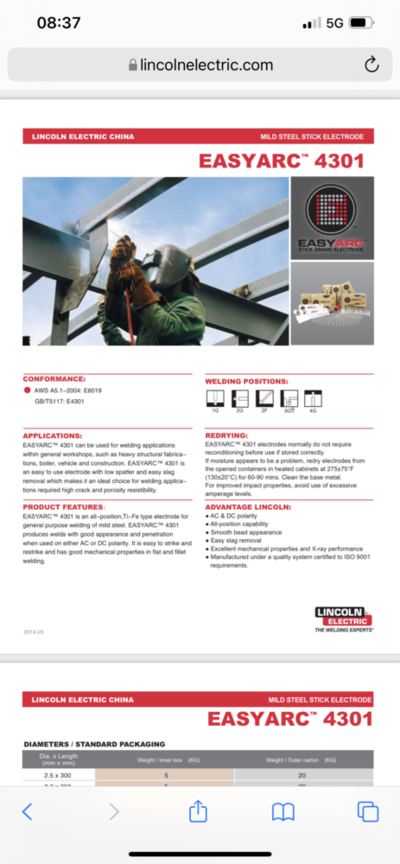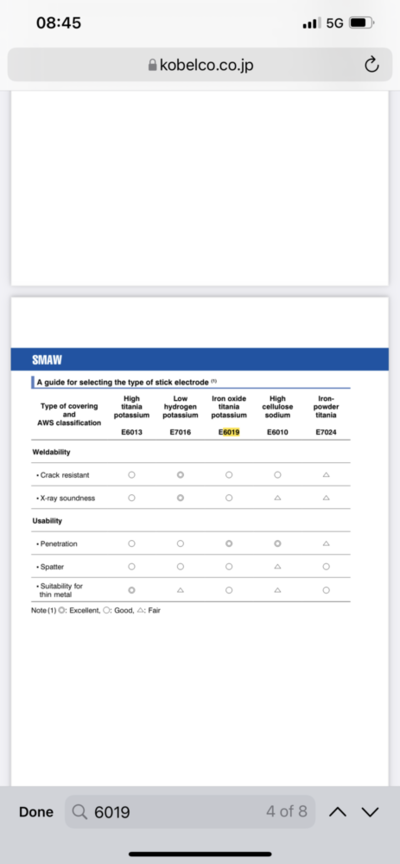You are using an out of date browser. It may not display this or other websites correctly.
You should upgrade or use an alternative browser.
You should upgrade or use an alternative browser.
Function of Iron Oxide in MMA Flux?
- Thread starter Jack Ryan
- Start date
premmington
Member
- Messages
- 6,554
- Location
- Norfolk
Come back "tech Al" all is forgiven! 

premmington
Member
- Messages
- 6,554
- Location
- Norfolk
Agroshield
Member
- Messages
- 6,380
This is pure speculation (i.e. high chance of BS), based on reading the manufacturer's product decsriptions.
The electrodes seem to be used for heavy plate welding. The manufacturers emphasise that the flux contains a lot of iron powder (which is not the same as iron oxide). This adds to the metal in the solid part of the electrode. I believe the welding term for this is 'recovery'. One of the ones below mentions 150% recovery. It sounds like they are near in function and construction to 7024 electrodes.
The iron oxide part, in the sheet below, is only noted as a coating rather than a main constiuent. Maybe it is used like a varnish, a thin skin to protect the iron powder from itself oxidizing (rusting). One of the sheets below says the electrode is OK for rusty or primer-coated materilals, and that the slag is self-releasing, so maybe the iron oxide helps with these two properties.
 certilas.com
certilas.com

 www.washingtonalloy.com
www.washingtonalloy.com
The electrodes seem to be used for heavy plate welding. The manufacturers emphasise that the flux contains a lot of iron powder (which is not the same as iron oxide). This adds to the metal in the solid part of the electrode. I believe the welding term for this is 'recovery'. One of the ones below mentions 150% recovery. It sounds like they are near in function and construction to 7024 electrodes.
The iron oxide part, in the sheet below, is only noted as a coating rather than a main constiuent. Maybe it is used like a varnish, a thin skin to protect the iron powder from itself oxidizing (rusting). One of the sheets below says the electrode is OK for rusty or primer-coated materilals, and that the slag is self-releasing, so maybe the iron oxide helps with these two properties.
E 7027 | Certilas

E6027 - Washington Alloy
E6027 AWS A5.1 Class E6027 USA 6027 is a heavy iron powder, iron oxide coated electrode developed to provide maximum depositionefficiency and deep penetration at higher speeds. It is particularly suited for welding flat, deep groove joints aswell as horizontal butt and fillet welds. USA 6027...
 www.washingtonalloy.com
www.washingtonalloy.com
Brad93
Member
- Messages
- 19,412
- Location
- Essex, United Kingdom
It's a type of coating, not too unlike a rutile coating to run. Ilmenite coating they call it, ilmenite is a mineral (compound?) found in the earth which is commonly used to make titanium dioxide (white pigment in paints etc etc).
Russians came up with it I believe. Don't think I've ever seen an 6019 here.
I don't know the mechanism of action, it's certainly not described in any esab or Lincoln literature I have. It also doesn't appear in Science and practice of welding.
Googling it; it seems to be a low cost electrode.
However it also says that additions of lanthanum and cerium are needed to improve mechanical properties. They're rare earth metals so not cheap.
It's likely that the disadvantages outweigh the advantages and it never made it commercially. The Russians like doing things different just because they've got the raw materials at hand. Didn't work out so well for their titanium subs either.
Russians came up with it I believe. Don't think I've ever seen an 6019 here.
I don't know the mechanism of action, it's certainly not described in any esab or Lincoln literature I have. It also doesn't appear in Science and practice of welding.
Googling it; it seems to be a low cost electrode.
However it also says that additions of lanthanum and cerium are needed to improve mechanical properties. They're rare earth metals so not cheap.
It's likely that the disadvantages outweigh the advantages and it never made it commercially. The Russians like doing things different just because they've got the raw materials at hand. Didn't work out so well for their titanium subs either.
Brad93
Member
- Messages
- 19,412
- Location
- Essex, United Kingdom
Thanks for the responses. I have done a bit more research and I think I have some satisfactory answers. Brad93 has mentioned some in his responses, The question was asked regarding MMA but the same applies to flux core wire - both gas shielded and self-shielded.
Increasing Deposition Rate
The purpose of the iron is to increase the deposition rate (a function now served by iron powder) but the question remained, why iron oxide and not iron powder? As is often the case, there is not a single answer.
Additional Oxygen
Where argon rich shielding gases are used, the additional oxygen in iron oxide increases the reactive component of the shielding gas. The reactive gas increases penetration and the removal of impurities through oxidation.
tubular wires are optimised for particular ranges of shielding gas and those designed to use high argon mixtures may need iron oxide additions to the core to restore the desired oxygen balance.
Tubular Wire Welding by D. Widgery, p44
Hydrogen Control
Resistance to hydrogen (water) absorption.
The extruded electrodes with rutile, iron oxide and silicate coatings do not pick up so much moisture from the atmosphere and function quite well with a small absorbed content.
Improved penetration (depth of fusion) with the addition of reactive oxygen.
In manual metal-arc welding the flux coating to give deep penetration characteristics would contain
(a) iron oxide
(b) manganese
(c) cellulose
(d) calcium carbonate.
The Science and Practice of Welding Volume 2 10th Ed - The Practice of Welding, p12& p510
Iron Oxide as a Slag Producer
Similarly, if we use iron oxide (Fe2O3) and silicon dioxide (SiO2) in the covering of the electrode, in the heat of the arc they will combine chemically to form iron silicate, which floats to the top of the molten pool as a slag, protects the hot metal from further atmospheric oxidation and slows down the cooling rate of the weld.
iron oxide + silicon dioxide = iron silicate
Fe2O3 + 3SiO2 = Fe2(SiO3)3
The Science and Practice of Welding Volume 1 10th Ed - Welding Science and Technology, p58
There are other combinations as well such as Exx20 with a high iron oxide coating bonded with sodium silicate. It looks like iron oxide is firmly in the past now as ISO 2560 does not even list it as an option.
Thanks again,
Jack
Increasing Deposition Rate
The purpose of the iron is to increase the deposition rate (a function now served by iron powder) but the question remained, why iron oxide and not iron powder? As is often the case, there is not a single answer.
Additional Oxygen
Where argon rich shielding gases are used, the additional oxygen in iron oxide increases the reactive component of the shielding gas. The reactive gas increases penetration and the removal of impurities through oxidation.
tubular wires are optimised for particular ranges of shielding gas and those designed to use high argon mixtures may need iron oxide additions to the core to restore the desired oxygen balance.
Tubular Wire Welding by D. Widgery, p44
Hydrogen Control
Resistance to hydrogen (water) absorption.
The extruded electrodes with rutile, iron oxide and silicate coatings do not pick up so much moisture from the atmosphere and function quite well with a small absorbed content.
Improved penetration (depth of fusion) with the addition of reactive oxygen.
In manual metal-arc welding the flux coating to give deep penetration characteristics would contain
(a) iron oxide
(b) manganese
(c) cellulose
(d) calcium carbonate.
The Science and Practice of Welding Volume 2 10th Ed - The Practice of Welding, p12& p510
Iron Oxide as a Slag Producer
Similarly, if we use iron oxide (Fe2O3) and silicon dioxide (SiO2) in the covering of the electrode, in the heat of the arc they will combine chemically to form iron silicate, which floats to the top of the molten pool as a slag, protects the hot metal from further atmospheric oxidation and slows down the cooling rate of the weld.
iron oxide + silicon dioxide = iron silicate
Fe2O3 + 3SiO2 = Fe2(SiO3)3
The Science and Practice of Welding Volume 1 10th Ed - Welding Science and Technology, p58
There are other combinations as well such as Exx20 with a high iron oxide coating bonded with sodium silicate. It looks like iron oxide is firmly in the past now as ISO 2560 does not even list it as an option.
Thanks again,
Jack



